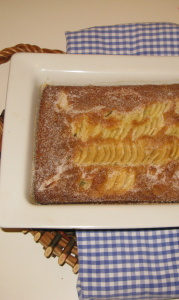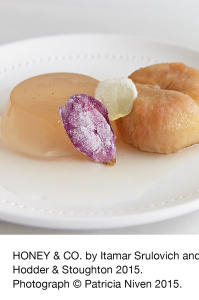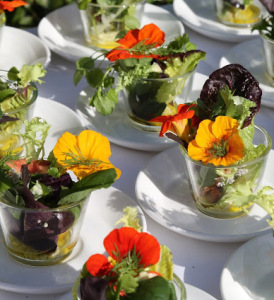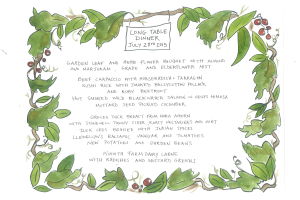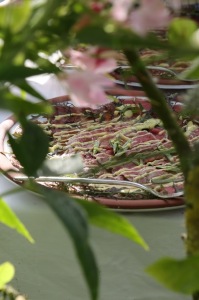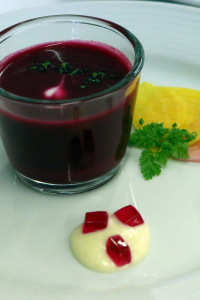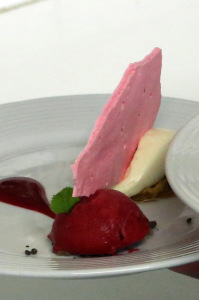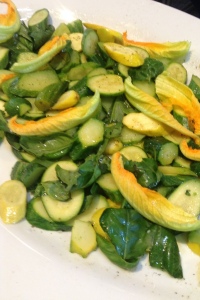Just heard the sad news of Mary Keane’s passing. Mary was often referred to as John B Keane’s wife as indeed she was for 47 years until his death in 2002 but Mary was a legend in herself. I only met her a couple of times but each encounter imprinted itself on my mind and I felt so fortunate that our paths had crossed. Mary had a wonderful way with words, I loved the colloquial language she used and how she seems so totally happy and confident in her own self and place. You might say, Well of course,  but it was an extra intangible something that was both inspirational and endearing and a rare enough quality.
In 2009 I had a wonderful morning with Mary learning how to make traditional Listowel Mutton Pies.  I was in the town for the annual Food Fair and of course strayed into the legendary family pub, I fell into lively company and we took to discussing food, local butcher turned bookie, Eric Brown regaled me with stories of the beef and kidney stew and the hare soup his mother used to make after the local coursing meeting. He taught me a new technique of skinning rabbits and slipped me a few tips for the next race meeting. Then who should come to the scene but the matriarch of the Keane dynasty, the doyenne of mutton pies herself, she being the winner of the Listowel Mutton pie competition in 2007, an accolade she was very proud of.  A spirited exchange took place between Mary, her son Billy, Jimmy Deenihan and several other punters about the traditional mutton pie. It was wonderful stuff, everyone had an opinion but what was most thrilling for me was the discovery that the pie tradition is still alive and well in Listowel, Co Kerry. I wished I’d had a video camera to record this exchange. I was still thinking about it when I woke the following morning, so on impulse I picked up the phone and asked Mary to show me herself – I thought the worst she could do was say no if it didn’t suit her. She was still in ‘her nightdress’ and hadn’t even had a cup of tea when I rang but she said she’d do her best to find someone to stand behind the bar while she ran out to the butcher to get some mutton, “I have the self raising flour and the margarine but I’ll need a drop of buttermilkâ€
We met in the little kitchen behind the pub around 11am.  All the ingredients, plus salt, ground white pepper and a rolling pin were laid out on the table. Mary had already started to chop and was sharpening a knife on a fragment of whet stone as I arrived. She put me to work right away “Cut the meat cut into tiny cubes, not more than 1/8 of an inch†There was a mixture of shoulder, lap and shank in what we had. The chopped meat went into a green Tupperware bowl and was seasoned liberally with salt and finely ground white pepper. Next the pastry, Mary put about 1 ½ lbs self raising flour into a bowl, a pinch of salt and enough buttermilk to mix. It was more like bread dough really than a pastry. Mary gathered it all together, then kneaded it for a minute or two, before rolling out to a thickness of about ¼ inch with the wooden rolling pin. Then she took a saucer out of the cupboard and used it as a template to cut out rounds of dough
Mary was taught how to make traditional pies by her mother in law, Hannah Purtill a member of Cumann na mBan, who lived in a house in Church Street. One at a time each circle of dough was rolled into a thinner round. Mary put a generous half fistful of mutton into the centre, brushed the edges with buttermilk and then pressed another round onto the top, the edges were pressed together to seal and then pricked with a fork 4 or 5 times.
By now the oven had been preheated to 230°C (450ºF) so the pies were baked 3 or 4 at a time on a baking tray – we made 8 in all.
According to Mary, the tradition of pie making in Listowel came about because the women wanted to go to the races, they didn’t want to be deprived of their fun so they made a ‘blast of pies’ a few days before the famous Listowel races. The way Listowel mutton pies are eaten is unique. The pastry is quite robust because of the small proportion of shortening to flour, not at all fragile. A big pot of mutton broth is made from the bones with maybe an onion or two added. On race day, the pies are slipped, a couple at a time into the pot of strained broth. They simmer away gently for 15 or 20 minutes and are then served into wide shallow soup bowls with a ladle full of hot broth on top. They are eaten with a spoon and a fork and some extra salt and pepper if you like.
Mary told me that her pies were never quite right for John B, “he was always cribbing that the pastry was always a bit too thick or too thin, not like his mothersâ€, so eventually she said “Well you can try your hand at it yourself.†So for a whole day before race week in Listowel, in the little kitchen behind the pub, ‘I’d put a bib on him’ and we’d cut up the meat for the pies to have a supply for the pub for race week’. Can you imagine the chat and banter while the two of them made pies together – wish I’d been a fly on a wall?
Listowel Mutton Pies
Despite the fact that mutton is having a terrific revival in the UK it is still very difficult to find mutton in Ireland so use hogget instead (the name for more mature lamb between Christmas and Easter.)
Makes 8
450g (1lb) mutton or hogget–a mixture of neck, shank and scrag end buy a bit more to allow for trimming.
lots of salt and ground white pepper
Pastry
900g (2lb) white flour
½ teaspoon salt
110g (1/4lb) Stork margarine or butter
850ml (1½ pints) buttermilk
Mutton Broth
2-2.5kg (4-6lb) mutton or hogget bones approximately
3-4 large onions, peeled and quartered
a couple of carrots, stalks of celery, parsley stalks, a couple of sprigs of thyme and pepper. OR a stock cube, which Mary occasionally uses.
First prepare the lamb. Trim off the fat and any gristle or membrane. Cut into tiny pieces (roughly 1/8 inch) and put into a shallow bowl. Season well with salt and ground white pepper (the kind that comes in a little cardboard shaker). Toss to make sure the meat is evenly coated.
Then, make the pastry. Put the flour into a bowl. Rub in the margarine or butter, add the buttermilk and mix with your hand to a firm dough, similar though drier than the texture of white soda bread. Mary kneaded the dough for 30 seconds to 1 minute to firm it up. Divide into two pieces. On a floured board, roll the pastry out as thinly as possible, to about 5mm (¼ inch). Mary used a saucer as a template and cut out 8 circles. Take one round and roll it out a little further to thin the pastry to approximately 2-3mm (1/8 inch).  Put a good half fistful of seasoned mutton or hogget into the centre. Brush the edge of the pastry with a little buttermilk and cover with another round that has also been rolled to 1/8-inch thickness. Press the edges together with the tines of a fork, then prick the top several times.
Preheat the oven to 230ºC/450ºF/gas mark 8. Meanwhile, continue to make the remainder of the pies. When the first four are ready, cook on a baking tray in the preheated oven for 20-30 minutes. Check occasionally and reverse the tray from back to front if necessary. Meanwhile, continue to make the pies until all the pastry and filling is used up. Cool the pies on a wire rack. At this point, they can be kept wrapped for several days or frozen for later use.
Meanwhile make a simple mutton stock.
Put the mutton or hogget bones into a deep saucepan, add a couple of peeled chopped onions, cover with cold water, bring to the boil, cover and simmer for 1-1½ hours. Strain. Mary said she adds a couple of stock cubes to add extra flavour but if you would rather not, I suggest adding a few thickly sliced carrots and a few sticks of celery, a sprig or two of thyme, some parsley stalks and maybe a sliced white turnip, if available, to add extra flavour to the broth.
Strain and taste, add salt and pepper to correct the seasoning. Save until needed. The broth will keep in a fridge for several days or may be frozen.
To serve the mutton pies – bring the broth to the boil in a deep saucepan, drop a couple of meat pies into the broth. Simmer for 20 minutes. Remove with a slotted spoon. Transfer each pie into a wide shallow soup bowl. Pour a ladle of mutton broth on top. Eat with a fork and spoon and extra pepper and salt, depending on your taste.
Kerry Pies
Mutton pies, made in Kerry, were served at the famous Puck Fair in Killorglin in August and taken up the hills when men were herding all day. The original hot water crust pastry was made with mutton fat but we have substituted butter for a really delicious crust.
Serves 6
1 lb (450g) boneless lamb or mutton (from shoulder or leg – keep bones for stock)
9 1/2 oz (275g) chopped onions
9 1/2 oz (275g) chopped carrots
1 teaspoon parsley
1 teaspoon thyme leaves
1/2 pint (300ml/) mutton or lamb stock
2 tablespoons flour
salt and freshly ground pepper
Hot Water Crust Pastry
12 oz (340g) white flour
6 oz (170g) butter
4 fl oz (100ml) water
pinch of salt
1 egg beaten with a pinch of salt to glaze
2 tins, 6 inches (15cm) in diameter, 1 1/2 inches (4cm) high or 1 x 9 inch (23cm) tin
Cut all surplus fat away, then cut the meat into small neat pieces about the size of a small sugar lump. Render down the scraps of fat in a hot, wide saucepan until the fat runs. Discard the pieces. Cut the vegetables into slightly smaller dice and toss them in the fat, leaving them to cook for 3-4 minutes. Remove the vegetables and toss the meat in the remaining fat over a high heat until the colour turns. Stir the flour into the meat. Cook gently for 2 minutes and blend in the stock gradually. Bring to the boil, stirring occasionally. Return the vegetables to the pan with the parsley and thyme leaves, season with salt and freshly ground pepper and leave to simmer, covered. If using young lamb, 30 minutes will be sufficient; an older animal may take up to 1 hour.
Meanwhile make the pastry. Sieve the flour and salt into a mixing bowl and make a well in the centre. Dice the butter, put it into a saucepan with the water and bring to the boil. Pour the liquid all at once into the flour and mix together quickly; beat until smooth. At first the pastry will be too soft to handle but as it cools it will become more workable. Roll out to 2.5mm/1/4 inch thick, to fit the tin or tins. (The pastry may be made into individual pies or one large pie.)
Fill the pastry-lined tins with the slightly cooled meat mixture. Make lids from the remaining pastry, brush the edges of the base with water and egg wash and put on the pastry lids, pinching them tightly together. Roll out the trimmings to make pastry leaves or twirls to decorate the tops of the pies, make a hole in the centre and egg wash carefully.
Bake the pie or pies at 200C/400F/regulo 6 for 40 minutes approx. Serve hot or cold
Kerry Yellow meal Griddle Bread
Mrs McGillycuddy of Caragh Lake in Kerry described this griddle bread to me. It dates back to the middle of the 19th century. Two different grades of yellow meal can still be bought in Foley’s grocery shop in Killorglin so obviously it is still used in this area.
Serves 4
4ozs /110g yellow meal
good pinch salt
¼ teaspoon bread soda
6 fl ozs (175ml) buttermilk
griddle or 10 inch (25.5cm) non stick pan
Put the yellow meal, salt and sieved bread soda into a bowl, add the buttermilk and beat well with a wooden spoon.
Heat a griddle until hot.(I use a non stick pan.) Pour the batter onto the griddle and cook until crisp and golden underneath about 4 or 5 minutes. Turn over carefully and continue to cook on the other side, cut into four. Serve warm with country butter. This is very good served with crispy bacon for breakfast or supper.
Traditional Kerry Apple Cake
Â
Makes 25-30 pieces
450g (1lb) plain white flour
175g (6oz) butter
2 teaspoons baking powder
175g (6oz) castor sugar
3 free range eggs
225ml (8fl oz) milk
1/2 teaspoon ground cloves
2 cooking Bramley apples
Baking tin 30x20cm 7.5cm deep (12x8in 3in deep)
Preheat the oven to 200C/400F/gas mark 6.
Peel, core and chop the apple into 5mm (1/4in) dice. In a large bowl, rub the butter into the flour. Add the baking powder, castor sugar, diced apple and 1/2 teaspoon ground cloves. Whisk the eggs with a cup of milk in another bowl. Add to the dry ingredients and mix well with a wooden spoon, the mixture will be a soft texture. Pour into the greased and lined roasting tin. Bake at 200C/400F/gas mark 6 for 35 to 40 minutes or until the apples are soft and the top is golden brown. Dredge with soft brown sugar while hot, cool and serve.
Hot Tips
Date for your Diary
Diana Dodog, winner of the 2014 Irish Masterchef, will host a Five Mile Dinner at Dunowen House, Clonakilty on Wednesday 9th September at 7pm. Champagne cocktail on arrival followed by a five course meal featuring local produce.
Dinner €60 per person. Contact bookings@dunowenhouse.ie or tel: 023 886 9099
One of my favourite Dublin eateries Brother Hubbard on Capel Street is now open in the evenings from Wednesday-Saturday. They are offering a Middle Eastern Feasting Menu featuring a vegetarian mezze platter to share, choice of main dishes and a dessert platter….
Brother Hubbard are also planning a separate evening concept for Sister Sadie next month.
Updates on twitter @brother_hubbard, facebook and Instagram brotherhubbard#MiddleEastFeast

